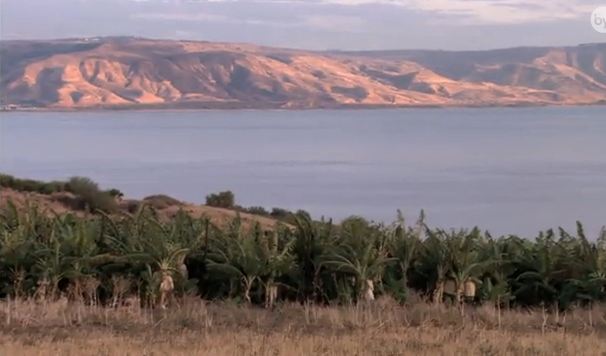JOHN W. WELCH: At the very center of both the Sermon on the Mount and the Sermon at the Temple, we find the jewel of the Lord’s Prayer. Before this, He had said, when you pray individually, go into your closet. But then it shifts to a plural—when ye pray, you should all pray in this manner. He instructs people then in a formal prayer, that in a way encapsulates the entire mystery of godliness, and all of what people knew and did in temple settings in the ancient world.
VICTOR LUDLOW: At the very beginning of the Lord’s Prayer, where our Heavenly Father is addressed, which is the way we understand we should start our prayers, there is an expression of praise given: “Hallowed be thy name.”
In the psalms, there are psalms of praise and psalms of thanks. But how scholars distinguish these two psalms, because they’re very similar, is that thanks recognizes God for what He does; praise recognizes God for who He is. And this phrase, hallowed be thy name is where the Savior is recognizing the Lord a little bit more for who He is, His quality, His character. And as we recognize His glory, His nobility, His divinity, His love, His charity, I think we are expressing praise, whether we do it out loud or not.
JOHN W. WELCH: The Lord’s Prayer includes the most solemn petition: “Forgive us our debts, as we forgive our debtors.” Here’s the key to how we will be given mercy. If we don’t forgive other people, we won’t qualify to receive the forgiveness of God.
FRANK F. JUDD: The doxology at the end of the Lord’s Prayer is actually absent from the earliest and best manuscripts of the New Testament. But the Book of Mormon account in the Sermon at the Temple has it. And so one has to wonder why it may have been taken out early on in the history of the manuscripts in the New Testament. But as it stands, the doxology, “For thine is the kingdom and the power and the glory, forever. Amen,” really emphasizes the idea that even though we are to ask for blessings from the Lord, and we are to use those blessings to help others, that in the end all that we have and all that we are really are from the Lord, and we simply give back to Him, and help others along the way.
JOHN W. WELCH: The ceremonies of temples in the ancient world were all about glorifying and praising God, recognizing His power and authority, giving Him the glory and submitting ourselves to His will.
Following His words from the Sermon on the Mount, Christ performs miracle after miracle, reflecting in deed and action the spirit and nature of His gospel teachings. The progression of Christ’s miracles towards the ultimate act of raising the dead, are poignantly analogous to Christ’s own life and ministry.
JOHN F. HALL: The question about the miracle at Cana is: Why is it emphasized so greatly in the gospel of John? Because it’s a fairly straightforward miracle. Christ has water bottles filled with water and turns them to wine. The occasion of the miracle is often discussed. It’s a wedding feast. Mary His mother certainly has some role of importance in that feast. She’s concerned that the wine has been depleted and asks Christ to supply more.
ROGER R. KELLER: His response to her seems a little bit harsh. He says, “Woman, what have I to do with thee? Mine hour has not yet come.” In the Joseph Smith translation of this particular response to Mary, it says, “What wilt thou have me do for thee? That will I do, for mine hour is not yet come.”
So again, it’s this intimate relationship between Mary and her son Jesus that is being emphasized here. She must know that He has the power to do something about this very embarrassing situation for this young couple. For them to run out of wine during the wedding would have been a social faux pas to say the least. And so has she seen Jesus’ power in His younger years, in those lost years where we really know nothing about him? I think we must probably conclude that she has seen His power used in ways that would benefit people and she knows He can help her.
Now when He says, “My hour has not yet come,” His hour really is that moment in time when he begins to move inexorably toward Gethsemane and the cross in the Gospel of John. That’s His hour, and it is not quite yet time for Him to offer Himself up. But everything from here on now is the prelude to that.
JOHN F. HALL: Christ, in choosing to perform this miracle (and John in choosing to emphasize it in the second chapter of the Gospel) does so because it’s symbolic of the mission of Christ, that Christ will perform an atoning sacrifice, and that the wine, representative of the blood, will be symbolic of that sacrifice that Christ will perform.
ROGER R. KELLER: The reason this is perhaps the first sign in the Gospel of John, is that it has to point toward the new wine of the gospel. It must also probably prefigure the Atonement of Christ and His shed blood, as well as prefiguring the Last Supper, which we all participate in as we take the sacrament and remember the blood which was shed for us. And it also points toward the millennial reign that is yet to come.
GAYE STRATHEARN: For the next several months, Jesus travels throughout the Galilee, teaching of His coming kingdom and healing the sick. This is a time where Jesus’ popularity reaches its zenith, where multitudes seek Him out to feast upon His words and to be healed of their afflictions.
It’s not surprising therefore that when Jesus returns home to Capernaum, a multitude gathers there also. Soon the house where He is staying is filled to overflowing. Every room is filled with people, and outside a crowd is also gathering. So Jesus does what He has come to do. He teaches His gospel. Mark records, Jesus preached the word unto them (Mark 2:2) But his teaching is interrupted by a tumult overhead. Suddenly the roof is ripped open, and a bed is lowered down. And on that bed is a paralyzed man.
ALISON COUTTS: The crowd has gathered obviously to see Him. And all of a sudden the roof opens up, and these four friends lower this man, a paralytic. Now it would have been easy for the Savior just heal him. He’s, he’s done this before. But instead He said, “Thy sins are forgiven.” This seems to be a great teaching moment here, that the Savior isn’t just here to alleviate our physical problems, but to heal the whole person. And the most important thing in this is not the physical healing but the spiritual healing. The scribes and the Pharisees were there. And they are already looking for an excuse get rid of this man who says He is the Son of God. By forgiving sins, the Savior is declaring who He is. Only God can forgive sins, this is well known. And so He’s directly confronting the scribes and the Pharisees.
VICTOR LUDLOW: Now it’s one thing to have this man paralyzed from the waist down first of all be able to stand up and walk, but considering what limited physical activity he must have participated in for who knows how many years, to lift up this cot with all of its framework that had to be strong enough to bear him on it, and carried it off by himself, was a absolutely impressive miracle to all that were there—both for the fact of the physical healing, but also for the promise of forgiveness of sin, indicating an individual who was more than a miracle worker, He was a true Anointed One of the Most High.
 PAUL Y. HOSKISSON: In the synoptic gospels, there’s this wonderful story about Jesus and the disciples trying to cross the Sea of Galilee, from the east side probably to the west side. And in the midst of this crossing, this terrible storm comes up. And in the midst of this storm, Jesus seems to be sleeping. And the apostles are a little bit worried. The disciples, according to Mark, go and wake up Jesus. He’s in the back part of the boat. And they say, “Master, carest thou not that we perish?” And Jesus gives a rather interesting answer. He rebukes them and, and in Matthew he talks about them: Where’s your faith at? He says, “Peace, be still,” and the storm stops, and the waves cease. And the apostles are astonished, as they say here: “What manner of man is this, that even the wind and the sea obey him?” (Mark 4:37–41).
PAUL Y. HOSKISSON: In the synoptic gospels, there’s this wonderful story about Jesus and the disciples trying to cross the Sea of Galilee, from the east side probably to the west side. And in the midst of this crossing, this terrible storm comes up. And in the midst of this storm, Jesus seems to be sleeping. And the apostles are a little bit worried. The disciples, according to Mark, go and wake up Jesus. He’s in the back part of the boat. And they say, “Master, carest thou not that we perish?” And Jesus gives a rather interesting answer. He rebukes them and, and in Matthew he talks about them: Where’s your faith at? He says, “Peace, be still,” and the storm stops, and the waves cease. And the apostles are astonished, as they say here: “What manner of man is this, that even the wind and the sea obey him?” (Mark 4:37–41).
JUSTIN SU’A: Now coming from them—they have seen Him bring sight to the blind, they have even seen Christ bring life to a cold corpse. But I believe that they feared exceedingly here, because they have come to the knowledge that nature obeys Christ, and at the very words, “Peace, be still,” the winds ceased and the storm calmed.
PAUL Y. HOSKISSON: He gets after them in verse 40, and it bothers a lot of people, why He would say this, and it did me for a long time too: Why are ye so fearful? How is it that ye have no faith?
Well, the boat’s gonna be swamped, they’re gonna die, and He says, Why don’t you have any faith? I suspect that this allegory is a future prophecy about what’s going to happen to them and to the church. If you envision the boat as being a symbol of the church later on, the apostles are in charge, they’re running the boat, Jesus really isn’t there later on, He’s already died, and He’s resurrected. He’s close by, but His presence isn’t there. And that’s symbolized in this story with Him sleeping in the back of the boat. He’s not awake, He’s not doing anything when the storm is raging, until they wake Him up. Eventually the church is gonna go into apostasy, it’s gonna sink. And all of the apostles are going to be lost, they’re going to die one after the other, of course with the exception of John. And the question at that point is, when you know there’s going to be an apostasy, you know that the church—the authority’s gonna leave the earth, you still need your faith. You need that faith that He’s talking about here. And I think He’s teaching them that, in spite of all the chaos and evil in the world that’s overwhelming you, your faith will carry you through, even if the boat goes down.
JUSTIN SU’A: Perhaps the storm that we read about here in Mark could represent the sinful and wicked world we live in. It might be symbolic of the times in our lives where we feel we have no control, where we feel like we are in despair, and the only person who can save us is the Savior. I love the counsel the Lord gives to Joseph Smith in Doctrine and Covenants 101:16, the reminder: “For all flesh is in mine hands. Be still, and know that I am God.” This scripture, and this example of Christ calming the storm teaches us that the Lord is ever near those who call on Him in times of great despair, and that He is always in control.
S. KENT BROWN: All four gospel writers speak of Jesus feeding the 5000. John tells us that the Passover season was nigh, and Mark specifies that the multitude sat on green grass. So it is springtime, very likely early April. And at that time of year, pilgrims came to this area, doubtless some wanting to hear the voice of the Galilean prophet. Might He heal some of their sick as He had done elsewhere?
JOHN S. TANNER: Another question on their minds might have been: Is this the promised Messiah, as He professed to be. But for whatever reason, they just thronged about Him, didn’t they. And He needed a respite from the multitudes that were pressing about Him, so He comes here to the northern Galilee.
S. KENT BROWN: I expect that there is some distance to the east of this spot, but I love the part that He doesn’t turn away from the multitudes, instead He teaches them. And after that, after a long day with them, He feeds them.








